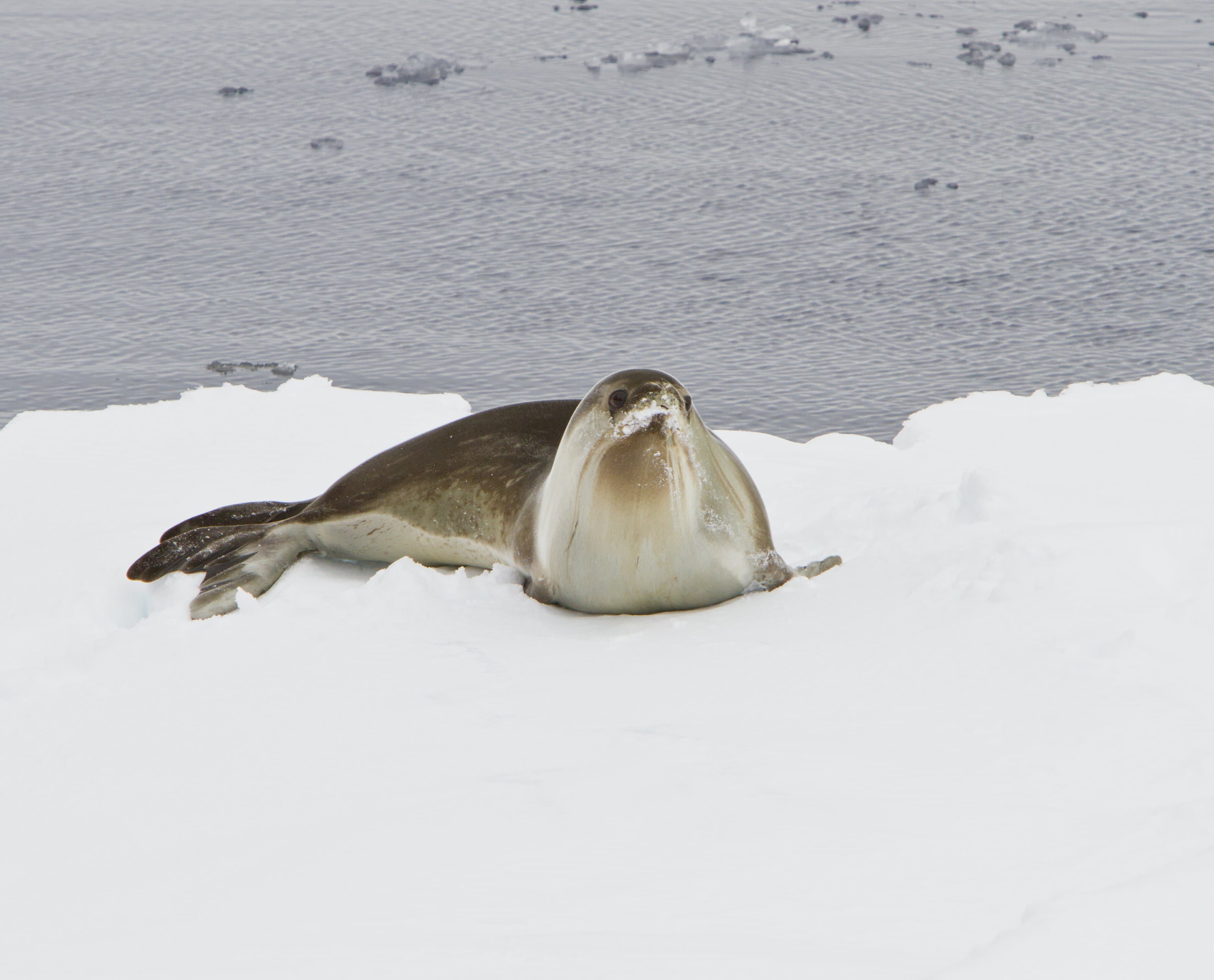6 Seals to Spot in the Southern Ocean

The seals and fur seals we encounter on our expeditions into the Southern Ocean all belong to a group of animals called the pinnipeds, which literally means “feather-footed.” Of course, they don’t really have feathers, but their wing-like flippers give them the ability to fly through the water with an easy, fluid grace that is absolutely wonderful to watch. We'll encounter up to six species of seals around the Antarctic peninsula as well as on South Georgia, each one with its own amazing adaptations to life in the frigid waters. From four-ton bull elephant seals to adorable Antarctic fur seal pups about the size of a loaf of bread, we’re always on the lookout for these fantastic animals, resting on the beaches, snoozing on floating ice or swimming like superb acrobats under our Zodiacs.
Leopard Seal
The leopard seal may be the most famous of all the seals we see in the Antarctic, mostly due to their reputation as ferocious predators of penguins. They're also known for their rather sinister appearance which comes from their huge, bullet-shaped heads, long, sharp canine teeth, and mouths that can open wide enough to bite a basketball! It’s a thrilling sight to watch this 10-foot-long, thousand-pound marine mammal snatching penguins out of the waves off the crowded breeding colonies, but you might be surprised to learn that their diet is actually about 70% krill and fish. Leopard seals are particularly fast and graceful in the water, and often very curious about boats, so we frequently get great looks at them twisting and spiraling through the water beneath our Zodiacs.
Photo: Ralph Lee Hopkins

Weddell Seal
As a biologist I’m a little reluctant to say this, but Weddell seals are probably the cutest of all the Antarctic seals with their big dark eyes, round heads, and short, whiskered snouts. But these seals aren't just a pretty face, they also have some amazing adaptations to support their challenging lives on the pack ice. They are skilled divers and can stay down for up to an hour and reach depths as great as 720 meters as they search for large fish such as Antarctic cod. They are always amusing to watch and capture everyone's hearts as we spot them popping their heads above the water or relaxing on ice close to the shore where they are safe from the killer whales that prey on them.Photo: Michael S. Nolan

Crabeater Seal
There are no crabs at all in the Southern Ocean around Antarctica, so the obvious question is: What do crabeater seals eat? The answer is krill, and they do it in an amazing way. Crabeater seals have very special teeth with several thin, blunt projections, like curling fingers. When the seal closes its jaws, these lobes from the top teeth interlock with those in the lower jaw and work like a sieve, allowing the seal to expel sea water and retain its mouthful of krill, just like the baleen of the great whales. “Crabbies,” as we like to call them, have beautiful silvery coats and are the most numerous seal in the world—there may be as many as twenty million of them around the White Continent.
Photo: Ralph Lee Hopkins

Antarctic Fur Seal
Fur seals are the odd one out in this group—they actually belong to a different family called the ‘eared seals’. Unlike the 'true seals' (all the others mentioned here), eared seals can walk on shore using all four of their flippers, and large forelimbs make them particularly fast, powerful swimmers. The females of this species are quite small, weighing only about 75 pounds, but the adult males are large and very aggressive, qualities that are key for defending their beach territories from rival males. Best of all are the fur seal pups, feisty, flappy and only the size of a small dog. It is an absolute joy watching them learn to swim as they jump and tumble over one another, a sight we come across often in South Georgia where you can find the world's largest population of Antarctic fur seals.
Photo: Michael S. Nolan

Southern Elephant Seal
The largest seals on Earth, male elephant seals can reach up to 8,000 pounds and legnths of more than 20 feet. When we encounter them on the beaches of islands around Antarctica and South Georgia they are usually quite sleepy and relaxed, so we can get a good look (as well as a good listen, these boisterous animals are known for their range of vocalizations). But it's important to keep our distance—if something disturbs them, they can move with amazing power and speed. Although we see them when they have come ashore to breed, they live most of their lives in a very different world. They are one of the deepest diving animals on the planet, regularly descending six thousand feet or more in pursuit of squid that are their prey. On the way down, they collapse their lungs and slowly sink into the dark depths while peacefully entering into a 'sleep spiral.'
Photo: David Cothran

Ross Seal
The recluses of the Antarctic, Ross seals are solitary animals whose lives are little known and very difficult to study. In fact, these residents of the vast areas of frozen ocean that surround the continent are among the least-known large mammals in the world. Relatively small seals, they are variable in color and appearance but often have beautiful silvery fur and elegant black streaks on their backs and chests. Their small, needle-like teeth probably indicate a diet of fish caught deep below the ice. Our Epic Antarctica voyage, which ventures into the Ross Sea, gives guests the rare chance to search for these elusive seals. It's a special moment if one is spotted and a huge thrill, even for the most experienced Antarctic traveler.

Main Image: Ralph Lee Hopkins
Featured Itineraries
Related Videos


